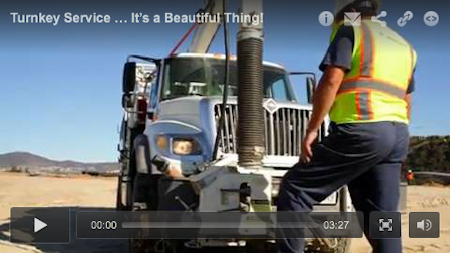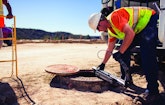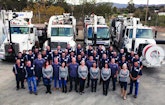
Victor and Wilma Roberts’ Escondido, Calif.-based firm has nearly doubled in size over the past decade, much of which has been plagued by the worst economy in America since the Great Depression. Clearly, the couple is doing something very right.
The company was built from an idealistic concept and a desire “to make sure our coastal and inland waters remain drinkable.”
It all bounces back, Victor Roberts says, to the Clean Water Act and how important clean water is for the nation as a whole. Having inherited a reverence for the natural world from his father — who wrote books on the flora and fauna of Baja California, and discovered some new species — Roberts isn’t shy about sharing his opinion on human responsibility to the environment.
“For us to be able to continue living on the land, our waterways need to remain clean,” he says.
Roberts picked up his dad’s mantle and decided to do something about it when he founded Downstream Services.
Downstream offers comprehensive pipeline inspection, cleaning and repair, as it did in the beginning. Since then the company has taken the next logical step in its evolution, now also serving as contractors who operate and maintain municipal and government agency wastewater systems, including instrumentation, pump repair and maintenance.
Evolution of a mindset
The company launched and built its expertise and reputation executing cleaning contracts for local beach areas in and around Escondido, eventually growing to serve all surrounding beach counties.
“CalTrans [the state’s DOT] started issuing contracts to clean their stormwater system and that’s really how we got started,” recalls Roberts. “We held that contract for 12 years for pipes, inlets and sediment disposal. Now all local cities have stormwater compliance divisions in place and are making sure everyone is complying with those local permits and the federal Clean Water Act for discharging water.” Then CalTrans took the work in-house. “As is typical, once agencies understand what needs to be done, they often buy their own equipment and bring the function in-house and only job out the specialized stuff,” he explains.
Ten years ago water-quality improvements were written into city management plans in Downstream’s territory, but they weren’t really monitoring water quality. Stormwater filters and related quality controls weren’t actively installed, but over the years those plans have been implemented. With water shortages becoming more common, cities now have compliance and monitoring in place and closely watch commercial businesses and facilities to make sure they’re treating water before it leaves their properties.
Specialize, then hone expertise
Downstream has been making an effort to go after these contracts in their area of expertise. “We’re always looking for ways to grow our business, both in municipal and government work. We try to combine our efforts all together. It’s basically flexing our muscles, doing things within our field all day long, getting stronger and more efficient at what we do and producing better results.”
Sticking to this strategy of staying close to its core competencies while slowly branching out into related areas has proven successful. Roberts believes strongly in sticking to what you know but working your tail off to learn a narrow niche deeply.
“The key to our growth is that we remain open to all possibilities within our skill specialties. Agencies are constantly looking for someone to do something better or more efficiently and are always trying out new solutions. So we stay current with new technology because these clients are the forerunners who have the budget from tax dollars to make their operations more effective.”
This dedication to constant improvement has allowed Downstream to build a reputation for safe operations that makes them a hot commodity in their service market. This is especially true with government agencies that answer to the public and need to avoid the kind of bad public relations that comes with accidents and injuries.
No unnecessary risks
“The military is mostly concerned with safety and they partner with their contractors,” Roberts explains. “Operations are based on safety protocols rather than efficiency or speed. We do not want anyone hurt or killed because we wanted to get a job done quicker, so we first identify safety concerns and what we can do to make sure our people and those around us aren’t injured.” It’s a philosophy the military understands and appreciates.
That’s not to say they don’t also appreciate speed within sound safety parameters. “We need to make sure we can provide the client with as efficient service as possible under those constraints, so everything we do is scrutinized by our people and the military clients,” Roberts says. “It’s a completely different way of doing business. In the past we’d ask, ‘How can we get this done quicker?’ Now safety is always our first protocol.”
To make sure it stays that way, Downstream staff are also certified under EM 385, the military’s safety bible. All military contractors must adhere to these protocols while working on bases. Downstream works on 15 bases, from Ventura to the Mexican border and the Tijuana Estuary.
Versatility and willingness
Roberts says it’s a pretty even split between municipal and military work for revenue generation. Major types of work include dig-and-replace and trenchless pipeline repair and rehabilitation, both standard and emergency response. CIPP is Downstream’s trenchless mode of choice, using the UV-cured Reline America system, which they also use for fiberglass sewer point repairs, generally confined to 10- to 30-foot sections. They’ve also installed Link-Pipe, a Canadian stainless steel expand-and-lock repair sleeve combined with grout.
Other infrastructure assets such as box culverts and manholes are also tackled as part of pipe repair projects. They’ll repair manholes with grout and then follow up with a two-part epoxy lining. “The Navy often has us rebuild manholes where there was such high hydrogen sulfide that it just got eaten away,” Roberts says. “It’s often more cost-effective for one or two manholes to hand-apply National Coating and Lining epoxy than to spray-apply. We prefer a sprayed-on finish, but out in the middle of nowhere we find hand application works best.”
Roberts believes that the company’s willingness to take on any job has been a significant driver of repeat business. “Small jobs are not a problem for us and that’s something we’re happy to do. It’s a large part of our business. We do a lot of emergency response with 24/7 on-call with the military and cities. It’s a requirement for the contracts for instrumentation and pump repair. Because we offer such a broad array of services we’re equipped to do an entire job in a few days rather than having to corral a bunch of subcontractors. And we can do it at a cost-effective price.”
This can-do attitude spurs confidence from clients, who look to Downstream for consultation, as well, Roberts says. “We have pretty much every kind of certification needed to do that. We don’t compete with engineers, but if a client has a specific site-oriented problem, we will come out, do an assessment and offer a remedy. That’s probably a major advantage we have in our market. We’ve done it all before and we’ve got a lot of highly educated people here, including three engineers who identify problems and can offer solutions. We specialize in the gap between the design and the field application.”
Technology is key
Downstream Services Inc. built its business on anticipating market needs and equipping itself with appropriate vehicles and tools to get the job done.
Roberts began with Camel combination wet-dry vacuum trucks and still runs five of them. A 2006 Isuzu chassis and a 1997 Ford both boast a 5-cubic-yard capacity and can move 65 gpm, while a 2006 Sterling, 2013 International and 2007 International carry 9-yard debris tanks and produce 150 gpm and 2,500 psi. Some have front-mounted reels and are used strictly for cleaning manholes from the street. Others have mid-mount reels on booms that can move 25 feet to the side to reach manholes behind sidewalks or over fences. These are used most frequently since most of their jobs are in remote, difficult-to-reach locations.
A 750-gallon pump trailer with a pressure washer and hot-water heater is built to handle spill responses. They also rely on an assortment of other pump and crane trucks, including two mini pumper trucks with 750-gallon tanks and a 1998 KW National three-axle flatbed with a 17-ton hydraulic crane, which are suited to a variety of conditions and tasks.
Inspection vans reveal Downstream’s preference for equipment from RS Technical Services Inc., which Roberts and his crews rely on for “ease of operation that guarantees consistent productivity. Repairs are easy to do ourselves, but we don’t have to do that often because they’re reliable and there aren’t many breakdowns unless the equipment is dropped by an operator.” Two Ford F350 vans and two 2010 Mercedes Benz Sprinters are outfitted with RS Technical Services inspection cameras and equipment along with Infrastructure Technologies pipeline survey and reporting software.
Downstream prefers to build out its own customized vans, which include a 2001 Isuzu box van that runs an Aries CCTV camera with a lateral launcher and a 2012 Mercedes Benz Sprinter instrumentation and control truck. They also have a 2009 Inuktun Long Range Camera/Sonar System with 5,280 feet of fiber optic cable and 2,000 feet of copper cable.
One of the more unique vehicles in the fleet is a 2014 Ford Transit Connect. The mini inspection system (see December 2014 Money Machines) features a 200-amp alternator that powers a 2,500-watt pure sine inverter from Dimensions Unlimited. Power stored in a 12-volt dry storage battery runs a 5-gallon washdown water supply with pump, front and rear LED traffic advisers, an RST compact portable reel, RST TrakSTAR II camera with TranSTAR steerable transporter and an RST mini mainline controller.
Past and future
Downstream’s stable of equipment has evolved with the industry. Before 1995 everything was in upheaval where stormwater was concerned in Southern California. Then a lawsuit between environmentalists and CalTrans forced compliance with the Clean Water Act. After that, Roberts recalls, the stormwater and wastewater treatment industry matured professionally.
“Back then nobody knew what the real problems were or how to solve them. When we bid on a related job in 1997, we were the only bidder. No one knew how to do this or what to do. Even the client didn’t really know what they needed to do to become compliant. We thought we could make it work and solve the problem, and being willing to take some risks made us successful. Now there are best practices, guidelines are in place and there is outreach to monitor and fix the problem.”
While that’s great for the environment, it has also injected competition into Downstream’s markets. And in such markets Roberts says the key to success is to have deep pockets and be in it for the long run.
“You’re going to lose money until you can build up the capital to buy equipment and pay your people to attract the right ones. Build a reputation for doing things right the first time, and be a hands-on manager. If you can make it in a tough market, you can make it anywhere.”












